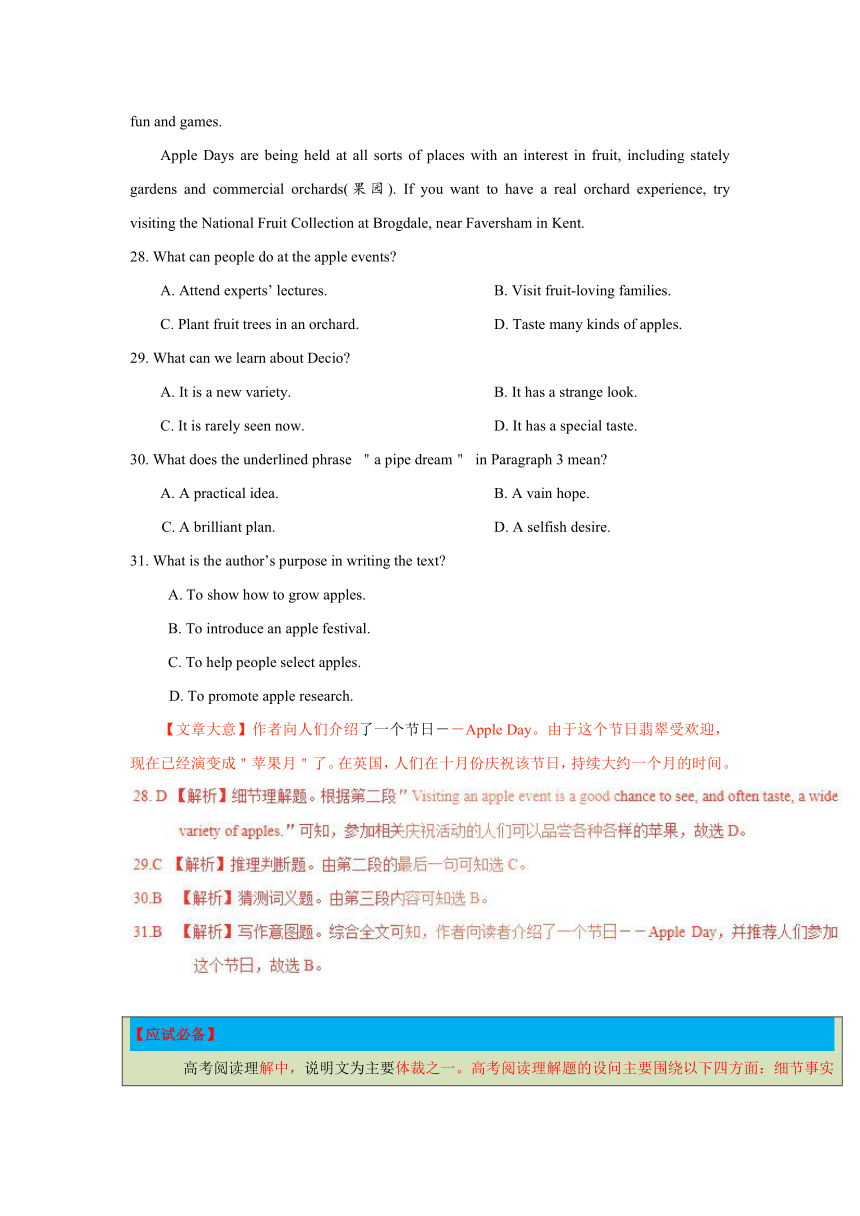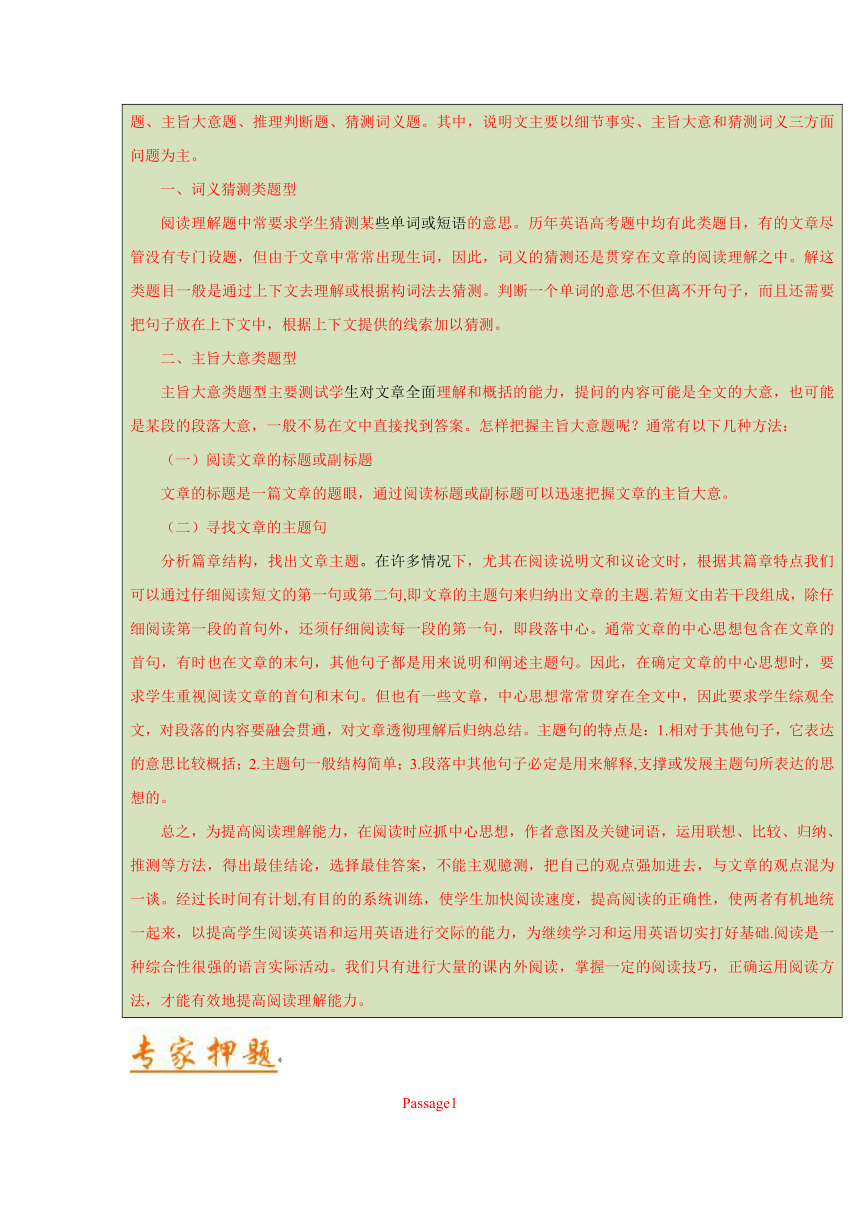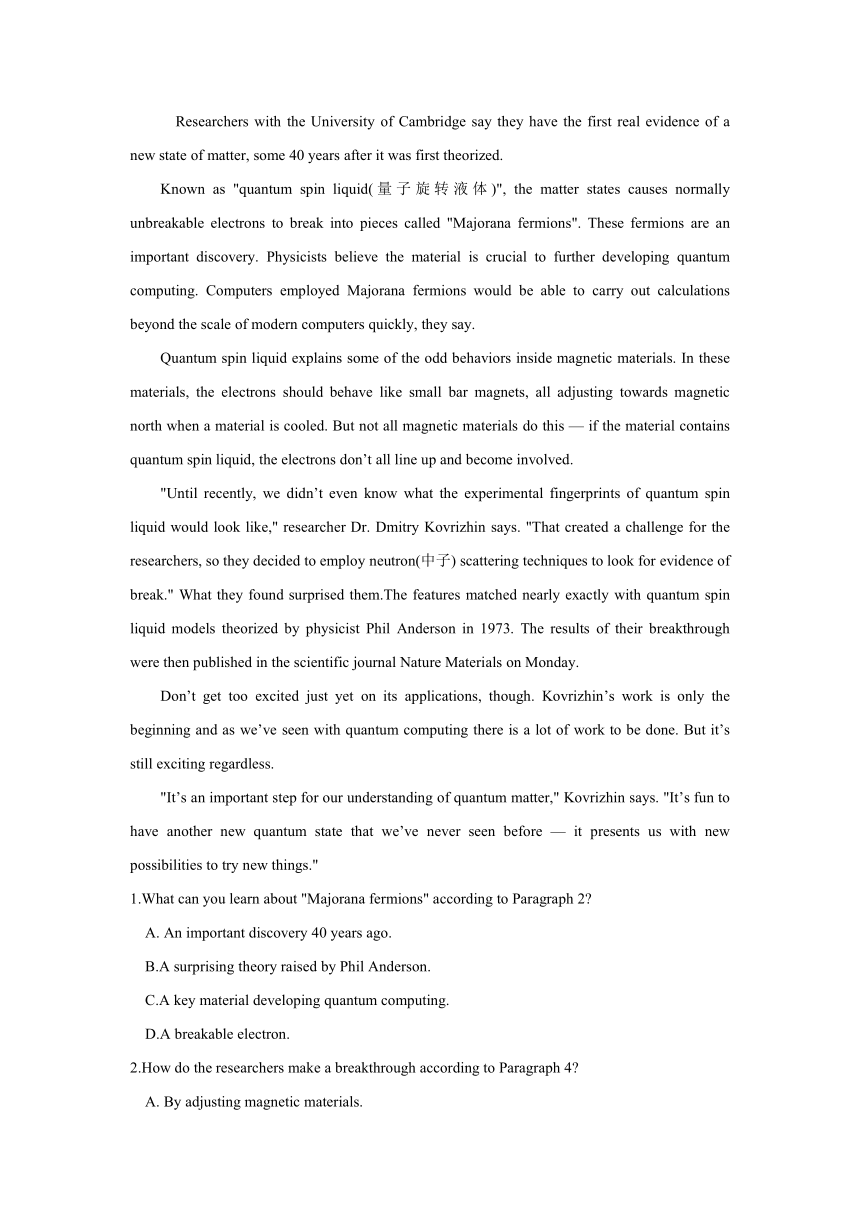2018年高考英语四轮复习押高考英语阅读理解D篇
文档属性
| 名称 | 2018年高考英语四轮复习押高考英语阅读理解D篇 |  | |
| 格式 | zip | ||
| 文件大小 | 565.5KB | ||
| 资源类型 | 教案 | ||
| 版本资源 | 通用版 | ||
| 科目 | 英语 | ||
| 更新时间 | 2018-05-10 07:38:25 | ||
图片预览




文档简介
2018年5月10日
高考频度:★★★★★ 难易程度:★★★☆☆
【考点猜想】
近年的新课标全国卷的阅读理解D篇基本上都是说明文。例如,2016年I卷D篇介绍了沉默在不同文化背景下的不同内涵;2017年I卷D篇主要介绍了一种自己可以亲手制作的简单易行的太阳能蒸馏器的方法,并介绍了它的工作原理。考题中有两道题是细节理解题,一道题是猜测短语含义(2016年改革中提到的猜测词义由一个单词改成句子或者短语);另一道题是推理判断,需要理解文章的段落含义才能准确选择。预测2018年高考全国卷会延续这种命题方式和考点设置,也很可能会设置主旨大意或观点态度题。
If you are a fruit grower — or would like to become one — take advantage of Apple Day to see what’s around. It’s called Apple Day but in practice it’s more like Apple Month. The day itself is on October 21, but since it has caught on, events now spread out over most of October around Britain.
Visiting an apple event is a good chance to see, and often taste, a wide variety of apples. To people who are used to the limited choice of apples such as Golden Delicious and Royal Gala in supermarkets, it can be quite an eye opener to see the range of classical apples still in existence, such as Decio which was grown by the Romans. Although it doesn’t taste of anything special, it’s still worth a try, as is the knobbly(多疙瘩的) Cat’s Head which is more of a curiosity than anything else.
There are also varieties developed to suit specific local conditions. One of the very best varieties for eating quality is Orleans Reinette, but you’ll need a warm, sheltered place with perfect soil to grow it, so it’s a pipe dream for most apple lovers who fall for it.
At the events, you can meet expert growers and discuss which ones will best suit your conditions, and because these are family affairs, children are well catered for with apple-themed fun and games.
Apple Days are being held at all sorts of places with an interest in fruit, including stately gardens and commercial orchards(果园). If you want to have a real orchard experience, try visiting the National Fruit Collection at Brogdale, near Faversham in Kent.
28. What can people do at the apple events?
A. Attend experts’ lectures. B. Visit fruit-loving families.
C. Plant fruit trees in an orchard. D. Taste many kinds of apples.
29. What can we learn about Decio?
A. It is a new variety. B. It has a strange look.
C. It is rarely seen now. D. It has a special taste.
30. What does the underlined phrase "a pipe dream" in Paragraph 3 mean?
A. A practical idea. B. A vain hope.
C. A brilliant plan. D. A selfish desire.
31. What is the author’s purpose in writing the text?
A. To show how to grow apples.
B. To introduce an apple festival.
C. To help people select apples.
D. To promote apple research.
【文章大意】作者向人们介绍了一个节日--Apple Day。由于这个节日翡翠受欢迎,现在已经演变成"苹果月"了。在英国,人们在十月份庆祝该节日,持续大约一个月的时间。
【应试必备】
高考阅读理解中,说明文为主要体裁之一。高考阅读理解题的设问主要围绕以下四方面:细节事实题、主旨大意题、推理判断题、猜测词义题。其中,说明文主要以细节事实、主旨大意和猜测词义三方面问题为主。
一、词义猜测类题型
阅读理解题中常要求学生猜测某些单词或短语的意思。历年英语高考题中均有此类题目,有的文章尽管没有专门设题,但由于文章中常常出现生词,因此,词义的猜测还是贯穿在文章的阅读理解之中。解这类题目一般是通过上下文去理解或根据构词法去猜测。判断一个单词的意思不但离不开句子,而且还需要把句子放在上下文中,根据上下文提供的线索加以猜测。
二、主旨大意类题型
主旨大意类题型主要测试学生对文章全面理解和概括的能力,提问的内容可能是全文的大意,也可能是某段的段落大意,一般不易在文中直接找到答案。怎样把握主旨大意题呢?通常有以下几种方法:
(一)阅读文章的标题或副标题
文章的标题是一篇文章的题眼,通过阅读标题或副标题可以迅速把握文章的主旨大意。
(二)寻找文章的主题句
分析篇章结构,找出文章主题。在许多情况下,尤其在阅读说明文和议论文时,根据其篇章特点我们可以通过仔细阅读短文的第一句或第二句,即文章的主题句来归纳出文章的主题.若短文由若干段组成,除仔细阅读第一段的首句外,还须仔细阅读每一段的第一句,即段落中心。通常文章的中心思想包含在文章的首句,有时也在文章的末句,其他句子都是用来说明和阐述主题句。因此,在确定文章的中心思想时,要求学生重视阅读文章的首句和末句。但也有一些文章,中心思想常常贯穿在全文中,因此要求学生综观全文,对段落的内容要融会贯通,对文章透彻理解后归纳总结。主题句的特点是:1.相对于其他句子,它表达的意思比较概括;2.主题句一般结构简单;3.段落中其他句子必定是用来解释,支撑或发展主题句所表达的思想的。
总之,为提高阅读理解能力,在阅读时应抓中心思想,作者意图及关键词语,运用联想、比较、归纳、推测等方法,得出最佳结论,选择最佳答案,不能主观臆测,把自己的观点强加进去,与文章的观点混为一谈。经过长时间有计划,有目的的系统训练,使学生加快阅读速度,提高阅读的正确性,使两者有机地统一起来,以提高学生阅读英语和运用英语进行交际的能力,为继续学习和运用英语切实打好基础.阅读是一种综合性很强的语言实际活动。我们只有进行大量的课内外阅读,掌握一定的阅读技巧,正确运用阅读方法,才能有效地提高阅读理解能力。
Passage1
Researchers with the University of Cambridge say they have the first real evidence of a new state of matter, some 40 years after it was first theorized.
Known as "quantum spin liquid(量子旋转液体)", the matter states causes normally unbreakable electrons to break into pieces called "Majorana fermions". These fermions are an important discovery. Physicists believe the material is crucial to further developing quantum computing. Computers employed Majorana fermions would be able to carry out calculations beyond the scale of modern computers quickly, they say.
Quantum spin liquid explains some of the odd behaviors inside magnetic materials. In these materials, the electrons should behave like small bar magnets, all adjusting towards magnetic north when a material is cooled. But not all magnetic materials do this — if the material contains quantum spin liquid, the electrons don’t all line up and become involved.
"Until recently, we didn’t even know what the experimental fingerprints of quantum spin liquid would look like," researcher Dr. Dmitry Kovrizhin says. "That created a challenge for the researchers, so they decided to employ neutron(中子) scattering techniques to look for evidence of break." What they found surprised them.The features matched nearly exactly with quantum spin liquid models theorized by physicist Phil Anderson in 1973. The results of their breakthrough were then published in the scientific journal Nature Materials on Monday.
Don’t get too excited just yet on its applications, though. Kovrizhin’s work is only the beginning and as we’ve seen with quantum computing there is a lot of work to be done. But it’s still exciting regardless.
"It’s an important step for our understanding of quantum matter," Kovrizhin says. "It’s fun to have another new quantum state that we’ve never seen before — it presents us with new possibilities to try new things."
1.What can you learn about "Majorana fermions" according to Paragraph 2?
A. An important discovery 40 years ago.
B.A surprising theory raised by Phil Anderson.
C.A key material developing quantum computing.
D.A breakable electron.
2.How do the researchers make a breakthrough according to Paragraph 4?
A. By adjusting magnetic materials.
B. By employing neutron scattering techniques.
C. By repeating maths calculations.
D. By changing electronic structure.
3.What is the author’s tone about the future of quantum matter?
A. Pessimistic. B. Doubtful.
C. Indifferent. D. Optimistic.
4.Which is the best title of the passage?
A. The Discovery of a New State of Matter.
B. Computer’s Future.
C. Majorana Fermions.
D. An Important Breakthrough.
Passage2
There is a popular saying in the English language: "Sticks and stones may break my bones, but words will never hurt me." Well, that is not true. Unkind words, name-calling or even the so-called "the silent treatment" can hurt children as much as being physically hit, sometimes even more so.
A recent study of middle school children showed that verbal(言语的) abuse by other children can harm development in the brain. The study was a project of researchers at Harvard Medical School in Massachusetts. Researcher Martin Teicher and his team studied young adults, aged 18 to 25. These young men and women had not ever been treated in a cruel or violent way by their parents. The researchers asked the young people to rate their childhood exposure to verbal abuse from both parents and other children. Then the researchers performed imaging tests on the brains of the subjects.
The images showed that the people who reported suffering verbal abuse from peers in middle school had underdeveloped connections between the left and right side of the brain. The two sides of the brain are connected by a large bundle of connecting fibers called the corpus callosum. This was the area that was underdeveloped.
The middle school years are a time when these brain connections are developing. So, unkind, hurtful comments from children or adults during this period have the greatest effect. The researchers tested the mental and emotional condition of all the young people in the study. The tests showed that this same group of people had higher levels of fear, depression, anger and drug abuse than others in the study.
The researchers published their findings online on the American Journal of Psychiatry’s website.
Parents cannot control what other people say to their children, but they can prepare their children.
1.Why does the author use the popular saying at the beginning?
A. To show the power of words. B. To introduce an opposite view.
C. To prove the author’s argument. D. To show ancient people’s wisdom.
2.What did the subjects have in common?
A. They were hurt by unkind words.
B. They performed poorly in imaging tests.
C. They had their brain slightly damaged.
D. They experienced no physical abuse at home.
3.What will be discussed in the next paragraph?
A. Comments on the findings. B. Approaches to further studies.
C. Suggestions to parents. D. Different opinions on the matter.
4.What is the main idea of the passage?
A. The way we speak matters.
B. Verbal violence should be stopped.
C. Unkind words hurt the brain.
D. Words are worse than sticks and stones.
Passage 1
【文章大意】这是一篇说明文,主要介绍了一项名叫"量子旋转液体"的新发现。
Passage2
【文章大意】本文是说明文。马萨诸塞州哈佛医学院的研究人员发现,语言暴力会干扰大脑神经的连接,对孩子的大脑发育造成不良影响。
1.B 【解析】考查作者意图。引用名人名言、谚语等是文章开篇的常见写作方式,且大多用来引出文章的话题。但是根据此谚语后面的"Well, that is not true. Unkind words, name-calling or even the so-called ‘the silent treatment’ can hurt children as much as being physically hit, sometimes even more so"可知,本文引用这个谚语恰恰是为了引出一个不同的或者说是相反的观点,故选B。
2.D 【解析】考查细节理解。根据第二段中的"These young men and women had not ever been treated in a cruel or violent way by their parents"可知,这些实验对象都没有遭受过父母的残酷或暴力对待,也就是说,他们在家里都没受到过身体上的虐待。故选D。部分考生会误选A项,原因在于考生看到了第三段中的"reported suffering verbal abuse from peers in middle school"而误认为所有的实验对象都遭受过语言暴力,但是根据前面的"the people who"可知,并非所有实验对象都遭受过语言暴力。
进步,在于总结。我在这,总结在哪儿?
________________________________________________________________________________________________________________________________________________________________________________________________________________________________________________________________________________________________________________________________________________________________________________
____________________________________________________________________________________________
____________________________________________________________________________________________
____________________________________________________________________________________________
高考频度:★★★★★ 难易程度:★★★☆☆
【考点猜想】
近年的新课标全国卷的阅读理解D篇基本上都是说明文。例如,2016年I卷D篇介绍了沉默在不同文化背景下的不同内涵;2017年I卷D篇主要介绍了一种自己可以亲手制作的简单易行的太阳能蒸馏器的方法,并介绍了它的工作原理。考题中有两道题是细节理解题,一道题是猜测短语含义(2016年改革中提到的猜测词义由一个单词改成句子或者短语);另一道题是推理判断,需要理解文章的段落含义才能准确选择。预测2018年高考全国卷会延续这种命题方式和考点设置,也很可能会设置主旨大意或观点态度题。
If you are a fruit grower — or would like to become one — take advantage of Apple Day to see what’s around. It’s called Apple Day but in practice it’s more like Apple Month. The day itself is on October 21, but since it has caught on, events now spread out over most of October around Britain.
Visiting an apple event is a good chance to see, and often taste, a wide variety of apples. To people who are used to the limited choice of apples such as Golden Delicious and Royal Gala in supermarkets, it can be quite an eye opener to see the range of classical apples still in existence, such as Decio which was grown by the Romans. Although it doesn’t taste of anything special, it’s still worth a try, as is the knobbly(多疙瘩的) Cat’s Head which is more of a curiosity than anything else.
There are also varieties developed to suit specific local conditions. One of the very best varieties for eating quality is Orleans Reinette, but you’ll need a warm, sheltered place with perfect soil to grow it, so it’s a pipe dream for most apple lovers who fall for it.
At the events, you can meet expert growers and discuss which ones will best suit your conditions, and because these are family affairs, children are well catered for with apple-themed fun and games.
Apple Days are being held at all sorts of places with an interest in fruit, including stately gardens and commercial orchards(果园). If you want to have a real orchard experience, try visiting the National Fruit Collection at Brogdale, near Faversham in Kent.
28. What can people do at the apple events?
A. Attend experts’ lectures. B. Visit fruit-loving families.
C. Plant fruit trees in an orchard. D. Taste many kinds of apples.
29. What can we learn about Decio?
A. It is a new variety. B. It has a strange look.
C. It is rarely seen now. D. It has a special taste.
30. What does the underlined phrase "a pipe dream" in Paragraph 3 mean?
A. A practical idea. B. A vain hope.
C. A brilliant plan. D. A selfish desire.
31. What is the author’s purpose in writing the text?
A. To show how to grow apples.
B. To introduce an apple festival.
C. To help people select apples.
D. To promote apple research.
【文章大意】作者向人们介绍了一个节日--Apple Day。由于这个节日翡翠受欢迎,现在已经演变成"苹果月"了。在英国,人们在十月份庆祝该节日,持续大约一个月的时间。
【应试必备】
高考阅读理解中,说明文为主要体裁之一。高考阅读理解题的设问主要围绕以下四方面:细节事实题、主旨大意题、推理判断题、猜测词义题。其中,说明文主要以细节事实、主旨大意和猜测词义三方面问题为主。
一、词义猜测类题型
阅读理解题中常要求学生猜测某些单词或短语的意思。历年英语高考题中均有此类题目,有的文章尽管没有专门设题,但由于文章中常常出现生词,因此,词义的猜测还是贯穿在文章的阅读理解之中。解这类题目一般是通过上下文去理解或根据构词法去猜测。判断一个单词的意思不但离不开句子,而且还需要把句子放在上下文中,根据上下文提供的线索加以猜测。
二、主旨大意类题型
主旨大意类题型主要测试学生对文章全面理解和概括的能力,提问的内容可能是全文的大意,也可能是某段的段落大意,一般不易在文中直接找到答案。怎样把握主旨大意题呢?通常有以下几种方法:
(一)阅读文章的标题或副标题
文章的标题是一篇文章的题眼,通过阅读标题或副标题可以迅速把握文章的主旨大意。
(二)寻找文章的主题句
分析篇章结构,找出文章主题。在许多情况下,尤其在阅读说明文和议论文时,根据其篇章特点我们可以通过仔细阅读短文的第一句或第二句,即文章的主题句来归纳出文章的主题.若短文由若干段组成,除仔细阅读第一段的首句外,还须仔细阅读每一段的第一句,即段落中心。通常文章的中心思想包含在文章的首句,有时也在文章的末句,其他句子都是用来说明和阐述主题句。因此,在确定文章的中心思想时,要求学生重视阅读文章的首句和末句。但也有一些文章,中心思想常常贯穿在全文中,因此要求学生综观全文,对段落的内容要融会贯通,对文章透彻理解后归纳总结。主题句的特点是:1.相对于其他句子,它表达的意思比较概括;2.主题句一般结构简单;3.段落中其他句子必定是用来解释,支撑或发展主题句所表达的思想的。
总之,为提高阅读理解能力,在阅读时应抓中心思想,作者意图及关键词语,运用联想、比较、归纳、推测等方法,得出最佳结论,选择最佳答案,不能主观臆测,把自己的观点强加进去,与文章的观点混为一谈。经过长时间有计划,有目的的系统训练,使学生加快阅读速度,提高阅读的正确性,使两者有机地统一起来,以提高学生阅读英语和运用英语进行交际的能力,为继续学习和运用英语切实打好基础.阅读是一种综合性很强的语言实际活动。我们只有进行大量的课内外阅读,掌握一定的阅读技巧,正确运用阅读方法,才能有效地提高阅读理解能力。
Passage1
Researchers with the University of Cambridge say they have the first real evidence of a new state of matter, some 40 years after it was first theorized.
Known as "quantum spin liquid(量子旋转液体)", the matter states causes normally unbreakable electrons to break into pieces called "Majorana fermions". These fermions are an important discovery. Physicists believe the material is crucial to further developing quantum computing. Computers employed Majorana fermions would be able to carry out calculations beyond the scale of modern computers quickly, they say.
Quantum spin liquid explains some of the odd behaviors inside magnetic materials. In these materials, the electrons should behave like small bar magnets, all adjusting towards magnetic north when a material is cooled. But not all magnetic materials do this — if the material contains quantum spin liquid, the electrons don’t all line up and become involved.
"Until recently, we didn’t even know what the experimental fingerprints of quantum spin liquid would look like," researcher Dr. Dmitry Kovrizhin says. "That created a challenge for the researchers, so they decided to employ neutron(中子) scattering techniques to look for evidence of break." What they found surprised them.The features matched nearly exactly with quantum spin liquid models theorized by physicist Phil Anderson in 1973. The results of their breakthrough were then published in the scientific journal Nature Materials on Monday.
Don’t get too excited just yet on its applications, though. Kovrizhin’s work is only the beginning and as we’ve seen with quantum computing there is a lot of work to be done. But it’s still exciting regardless.
"It’s an important step for our understanding of quantum matter," Kovrizhin says. "It’s fun to have another new quantum state that we’ve never seen before — it presents us with new possibilities to try new things."
1.What can you learn about "Majorana fermions" according to Paragraph 2?
A. An important discovery 40 years ago.
B.A surprising theory raised by Phil Anderson.
C.A key material developing quantum computing.
D.A breakable electron.
2.How do the researchers make a breakthrough according to Paragraph 4?
A. By adjusting magnetic materials.
B. By employing neutron scattering techniques.
C. By repeating maths calculations.
D. By changing electronic structure.
3.What is the author’s tone about the future of quantum matter?
A. Pessimistic. B. Doubtful.
C. Indifferent. D. Optimistic.
4.Which is the best title of the passage?
A. The Discovery of a New State of Matter.
B. Computer’s Future.
C. Majorana Fermions.
D. An Important Breakthrough.
Passage2
There is a popular saying in the English language: "Sticks and stones may break my bones, but words will never hurt me." Well, that is not true. Unkind words, name-calling or even the so-called "the silent treatment" can hurt children as much as being physically hit, sometimes even more so.
A recent study of middle school children showed that verbal(言语的) abuse by other children can harm development in the brain. The study was a project of researchers at Harvard Medical School in Massachusetts. Researcher Martin Teicher and his team studied young adults, aged 18 to 25. These young men and women had not ever been treated in a cruel or violent way by their parents. The researchers asked the young people to rate their childhood exposure to verbal abuse from both parents and other children. Then the researchers performed imaging tests on the brains of the subjects.
The images showed that the people who reported suffering verbal abuse from peers in middle school had underdeveloped connections between the left and right side of the brain. The two sides of the brain are connected by a large bundle of connecting fibers called the corpus callosum. This was the area that was underdeveloped.
The middle school years are a time when these brain connections are developing. So, unkind, hurtful comments from children or adults during this period have the greatest effect. The researchers tested the mental and emotional condition of all the young people in the study. The tests showed that this same group of people had higher levels of fear, depression, anger and drug abuse than others in the study.
The researchers published their findings online on the American Journal of Psychiatry’s website.
Parents cannot control what other people say to their children, but they can prepare their children.
1.Why does the author use the popular saying at the beginning?
A. To show the power of words. B. To introduce an opposite view.
C. To prove the author’s argument. D. To show ancient people’s wisdom.
2.What did the subjects have in common?
A. They were hurt by unkind words.
B. They performed poorly in imaging tests.
C. They had their brain slightly damaged.
D. They experienced no physical abuse at home.
3.What will be discussed in the next paragraph?
A. Comments on the findings. B. Approaches to further studies.
C. Suggestions to parents. D. Different opinions on the matter.
4.What is the main idea of the passage?
A. The way we speak matters.
B. Verbal violence should be stopped.
C. Unkind words hurt the brain.
D. Words are worse than sticks and stones.
Passage 1
【文章大意】这是一篇说明文,主要介绍了一项名叫"量子旋转液体"的新发现。
Passage2
【文章大意】本文是说明文。马萨诸塞州哈佛医学院的研究人员发现,语言暴力会干扰大脑神经的连接,对孩子的大脑发育造成不良影响。
1.B 【解析】考查作者意图。引用名人名言、谚语等是文章开篇的常见写作方式,且大多用来引出文章的话题。但是根据此谚语后面的"Well, that is not true. Unkind words, name-calling or even the so-called ‘the silent treatment’ can hurt children as much as being physically hit, sometimes even more so"可知,本文引用这个谚语恰恰是为了引出一个不同的或者说是相反的观点,故选B。
2.D 【解析】考查细节理解。根据第二段中的"These young men and women had not ever been treated in a cruel or violent way by their parents"可知,这些实验对象都没有遭受过父母的残酷或暴力对待,也就是说,他们在家里都没受到过身体上的虐待。故选D。部分考生会误选A项,原因在于考生看到了第三段中的"reported suffering verbal abuse from peers in middle school"而误认为所有的实验对象都遭受过语言暴力,但是根据前面的"the people who"可知,并非所有实验对象都遭受过语言暴力。
进步,在于总结。我在这,总结在哪儿?
________________________________________________________________________________________________________________________________________________________________________________________________________________________________________________________________________________________________________________________________________________________________________________
____________________________________________________________________________________________
____________________________________________________________________________________________
____________________________________________________________________________________________
同课章节目录
